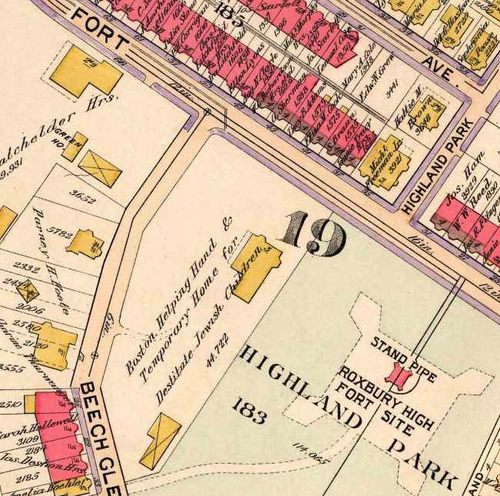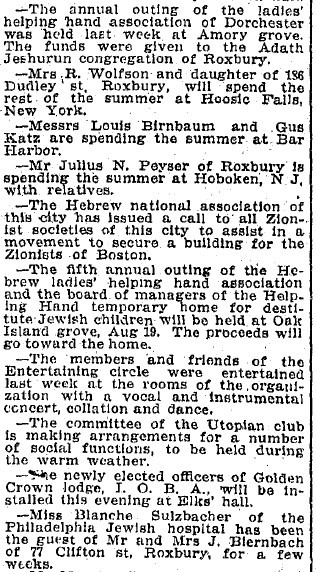Edit: Updated with additional info about the proposed JP location 10-14.
We’re used to thinking of Fort Hill, especially the area around the standpipe, as a sleepy residential area. But 100 years ago, this part of Roxbury was an integral part of the Boston landscape. And the landscape of the day included all kinds of social services, usually with amazingly descriptive names.
One of those names that is now lost to Roxbury is the Ladies Helping Hand Society Temporary Home for Destitute Jewish Children. This mouthful of an orphanage was the second major Jewish charitable institution in Boston. The first, the Leopold Morse Home for Aged and Infirm Hebrews and Orphans, had been operating in Mattapan for 10 years by the time the Helping Hand Home opened in 1899 on the corner of Beech Glen and Fort Avenue in the old St. Elizabeth’s Hospital building (subject of a future post).

Then as now, disputes over heritage caused friction even among people of the same religion living thousands of miles from home. As a result, the Morse Home catered to a mainly German Jewish orphan population at a time when the Jewish immigrants to Boston - those more likely to have children who might be so destitute as to need a home dedicated to them - were increasingly Russian. The Helping Hand Home, therefore, was a home not only intended for destitute Jewish children, but more specifically for destitute Russian Jewish children. Perhaps they thought that adding one more adjective to the name was overkill. Here’s a list of the “inmates” in 1910, entirely Russian except for two Austrian children.
Founded by the Russian-born lawyer and politician Samuel Borofsky and run by Louis “Papa” Cohen, the Helping Hand Home was located directly across the street from the Boston Nursery for Blind Babies. This wasn’t Borofsky’s first choice for a location. That was at a spot in Jamaica Plain, in what is now the parking lot behind Blanchard’s. But anti-semitism reared its head in a meeting of about 50 neighbors, who managed to get the JP location nixed on the grounds that it would “ruin values in the vicinity.”
The Fort Hill location, with its large German and Eastern European population anchored by the breweries and the German church, probably made more sense. And the hospital seems to have been a good fit. It had a capacity of 65 boys and girls, many of whom belonged to single parents who placed the children there temporarily until they were remarried or otherwise back on their feet.
But as Eastern European immigration continued to balloon during the first decade of the 1900’s, the demand for the services of the orphanage quickly outstripped its capacity. By 1907, the home’s directors had purchased an 80,000 square foot lot at the corner of Canterbury and Austin in Dorchester, and 4 years later the construction of a much larger facility was complete and the home had left our neighborhood. It continued providing services to Jewish orphans at that location until 1934, when it moved again to 35 Chestnut Hill Ave. in Brighton. From there, the story grows cold.
By the way, although I knew that Roxbury had once been one of the hubs of Jewish life in Boston, it wasn’t until I ran across this list of activities in the social pages of the July 13, 1902 Boston Daily Globe that I really got a sense of what that meant:

The site of the home is now one of the quieter parts of Highland Park. It’s hard to conceive of either a hospital or an orphanage on that hilly, secluded slope, but chances are that there are children or grandchildren of the inmates who spent time there still alive today.